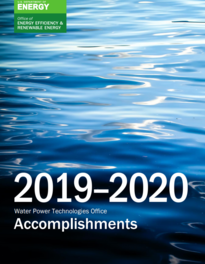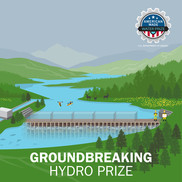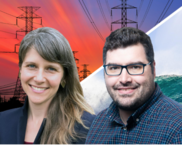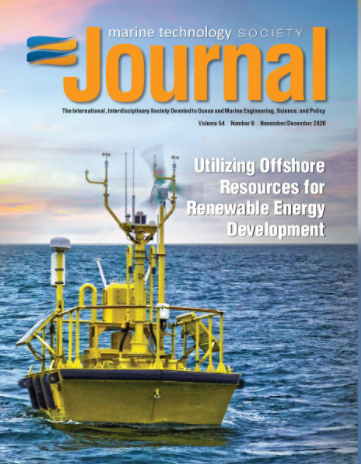 What’s Inside: This edition of the Water Wire shares upcoming deadlines, recent announcements and opportunities, prize updates, STEM spotlights, newly released products and publications, upcoming webinars, and other hot topics.
Continue to follow the Water Wire and emails from WPTO for the latest news and updates from the office. Reach out to WaterPowerTechnologiesOffice@ee.doe.gov with any inquiries or suggestions.
Estimated read time: 10 minutes
Upcoming WPTO Deadlines
- The deadline to compete in the Groundbreaking Hydro Prize is January 21, 2021, 5 p.m. ET.
- The deadline to submit applications for Energy Transitions Initiative Partnership Project (ETIPP) technical assistance is February 15, 2021. Learn more by registering for the ETIPP webinar, which will be held on Tuesday, January 26, 2021, at 12:00 pm MST.
- The deadline to compete in the first phase of the Ocean Observing Prize’s DEVELOP Competition and DESIGN Contest is February 16, 2021, 5 p.m. ET.
- The deadline to submit concept papers for the HydroWIRES Notice of Opportunity for Technical Assistance has been extended to February 17, 2021. Full applications are due April 14, 2021.
- The deadline to submit full applications for the Phase I Release 2 SBIR FOA is February 22, 2021, 5 pm. ET.
Announcements & Opportunities
WPTO Releases 2019–2020 Accomplishments Report

This month, WPTO released its 2019–2020 Accomplishments Report. This report summarizes significant results over the past two years from WPTO-supported research across its Hydropower and Marine and Hydrokinetics (MHK) programs. These accomplishments include successful laboratory and in-water tests of promising technologies, commercialization of environmental monitoring instrumentation, the release of new modeling code and decision-support tools, and efforts to improve open access to data. In the future, WPTO intends to publish these accomplishment reports on a regular basis. This first edition covers successes in both 2019 and 2020 and includes a “Looking Forward to 2021” section, which highlights a few projects that we predict will have significant results in 2021.
|
Energy Department Selects 10 Projects for Marine Energy Foundational R&D and Testing Infrastructure
On December 22, WPTO announced selections totaling up to $22 million for 10 projects to leverage the expertise and intellectual capital of research institutions by supporting marine energy foundational research and development (R&D) and expanded testing capacity. Additionally, WPTO is adding a new Atlantic Marine Energy Center to its partnership network and enlisting the support of a Network Facilitator to help coordinate and enhance WPTO-funded research results. By engaging and expanding its network of research organizations, as well as enhancing its facilitation and coordination with research partners, WPTO has a greater opportunity to maximize its impact across a range of issues important to the advancement of marine energy.
Prize Updates

I AM HYDRO Prize Winner Recap
Advanced manufacturing and hydropower could be a match made in heaven, lowering the costs of the hydropower components and systems designs that reduce the cost of hydropower-derived energy. Learn about the 11 winners of the American-Made Challenges’ I AM HYDRO Prize, who are claiming top honors to develop innovative concepts that will form the foundation of WPTO’s advanced manufacturing strategy.
|

Groundbreaking Hydro Prize
The deadline to compete in the Groundbreaking Hydro Prize is January 21, 2021, at 5:00 p.m. ET. WPTO launched the Groundbreaking Hydro Prize to encourage the development of new ideas to cut the costs, timelines, and risks associated with hydropower development. The Prize will award $300,000 in cash prizes. Three finalists will be selected as the winners, each receiving $50,000; up to six Innovator Prize winners will be selected to receive $25,000 each.
|
STEM Spotlight
Triton Stories: Do fish swim around or through energy devices in the water?
Marine energy harnesses the energy of waves, tides, and river currents using technologies like tidal turbines and wave energy converters. Understanding how animals, such as fish, diving seabirds, and marine mammals, behave around underwater devices is an ongoing goal for Pacific Northwest National Laboratory (PNNL) researchers. PNNL fish biologist Garrett Staines leads field trials research surrounding collision risk for animals and turbines for the Triton Initiative, a WPTO project dedicated to understanding the potential impacts of marine energy devices on the environment. Learn more about Staines’ work to understand collision risk, or the risk of animals interacting with moving parts or marine energy technologies.
PNNL Coastal Scientist Elected AAAS Fellow
PNNL’s Ron Thom was elected as a fellow of the American Association for the Advancement of Science (AAAS). Thom was selected for nearly five decades of research on coastal and estuarine ecosystem research. Thom joined PNNL’s Marine and Coastal Research Laboratory (MCRL) in Sequim, WA, in 1990, working as a research scientist and managing MCRL’s Coastal Ecosystem technical group for more than 20 years. Learn more about his career and noteworthy accomplishments.
Publications
New Sandia Report: Lessons Learned Based on Experience with Controls Awardees
Sandia National Laboratories recently released a publication, Lessons Learned Based on SNL Experience in Reviews of SPA Controls Awardees, which provides observations and technical suggestions for wave energy converter developers. Sandia’s role in the WPTO System Performance Advancement (SPA) program focuses on performing technical reviews and providing technical guidance to DOE on the performance of SPA funding awardees for controls and structures. Over the course of the SPA program, Sandia engaged five different R&D awardees who achieved an average 26.9% reduction in levelized cost of electricity and an 83.6% increase in Annual Energy Production compared to their beginning baseline. This report summarizes the key contributions and lessons learned from Sandia’s experience with these projects from 2013–2020.
Upcoming Webinars
Marine Energy Webinar for the National Ocean Sciences Bowl
Today, at 7:00 p.m. ET, WPTO and NREL will participate in a webinar with the National Ocean Sciences Bowl (NOSB). The NOSB is an academic competition and program that addresses a national gap in environmental and earth sciences in public education by introducing high school students to and engaging them in ocean science, preparing them for ocean science-related and other STEM careers, and helping them become knowledgeable citizens and environmental stewards. Attend the upcoming webinar and view past webinars from 2019 and 2020 featuring DOE and NREL experts on NOSB’s YouTube channel.
Introduction to New Open-source Marine Energy Software Package
Join NREL, Sandia, and PNNL on February 10 or February 18 at 12:00 p.m. ET to learn about new developments in the Marine and Hydrokinetic Toolkit (MHKiT), an open-source software package developed in Python and MATLAB that includes modules for ingesting, quality controlling, processing, visualizing, and managing marine energy data. The February 10 webinar will focus on MHKiT-Python and will include demonstrations in Python. The February 18 webinar will focus on MHKiT-MATLAB and include MATLAB demonstrations. Attend the webinars to learn about MHKiT functionality for ingesting modeled and observational data, applying quality control checks to the data, performing resource and power performance assessments, and characterizing mechanical loads. It is recommended that webinar attendees preinstall MHKiT and its dependencies by following the instructions on the installation page so they can follow along and try demonstrated functionality during the webinar.
Upcoming NHA Webinar—Digital Twins: A Tool for Modern Hydropower
On February 2, from 1:00–2:00 p.m. ET, the National Hydropower Association will host a virtual event, “Digital Twins: A Tool for Modern Hydropower.” Experts from the DOE National Labs, General Electric, and Chelan County Public Utility District will have a frank discussion about the benefits and challenges of ongoing hydropower Digital Twin developments. Updates will also be provided on recent efforts to create an industry-focused Digital Twin Framework, for which stakeholder feedback will be highly encouraged during and after the webinar. Register for this event.
Virtual Workshops for MHK Environmental Toolkit for Permitting and Licensing
Did you know DOE is sponsoring the development of a toolkit that contains GIS, environmental, and regulatory information relevant to marine energy permitting and licensing? The project team, led by Kearns & West, will host a series of workshops and other engagement opportunities in February and March to demonstrate the toolkit, gather feedback, and share experts’ understanding of potential impacts and the state of known/unknown science for MHK projects. Members of the marine energy community are invited to join and can register for general webinars on February 3 or February 9, a public Q&A session on March 15, and/or drop into the project team’s “Office Hours” on March 22. Additional information about the toolkit, including recordings of previous workshops and presentations from subject matter experts, is available online. If you would like to learn more about the project or attend one of the workshops, please email Natalie Raymores.
In Case You Missed It
WPTO Co-funds Solar-Hydro Hybrid Project with SETO
Through DOE’s Solar Energy Technologies Office Fiscal Year 2020 funding opportunity announcement, WPTO co-funded a project with Eagle Creek and General Electric for a hybrid solar photovoltaic (PV) and hydropower system. The project, “Increasing Renewable Generation and System Reliability through Coupling PV and Hydropower,” is developing a comprehensive science-based approach and toolset to evaluate, quantify, and demonstrate the advantages of a hydro-solar hybrid system. The project team will develop the design, algorithms, and control architecture that optimizes the attributes of a PV system coupled with an existing hydropower facility to provide the required flexibility, stability, and grid-forming capabilities needed for a resilient, secure, and affordable power grid.
Benefits and Potential of Floating Solar-Hydro Study
NREL recently published a study that found that linking floating solar panels and hydropower plants could potentially produce a significant portion of the world’s electricity. The researchers estimate that adding floating solar panels to bodies of water that are already home to hydropower stations could produce as much as 7.6 terawatts of potential power per year from the solar PV systems alone, or about 10,600 terawatt-hours of potential annual generation. Learn more about the study.

PNNL Duo Building a Bridge between Water-Power Researchers
The future of innovation in water and power is full of potential, and researchers thinking about the subject from different angles have a new creative space to collaborate. PNNL’s Rebecca O’Neil and Kostas Oikonomou are inviting researchers who study the structure, function, evolution, vulnerability, and resilience of coupled water and power systems across the world to join in collaborating on the topic. Along with colleague Masood Parvania, who leads U-Smart: Utah Smart Energy Laboratory at the University of Utah, they are starting a new task force within IEEE’s Power and Energy Society. IEEE is the world’s largest technical professional organization dedicated to advancing technology for the benefit of humanity. Learn more about the new task force.
|
PNNL’s Nick Ward Featured in AGU Podcast
Ahead of the AGU’s Fall 2020 meeting, PNNL featured coastal scientist, Nick Ward, in its SciVIBE podcast. While trees are known to absorb greenhouse gases, such as carbon dioxide, PNNL researchers have found that under certain circumstances, trees contribute more powerful greenhouse gas methane to the atmosphere. It can happen when seawater floods nearby forests—the flooding acts like a switch, causing release of methane from soil and trees. In some cases, enough fuel is bound within a tree’s tissues that it can, when manually released, sustain a flame. Ward discusses the work he is presenting at the Earth Science Conference AGU 2020 and how his colleagues expect the process to become more important as sea levels rise, causing more coastal forests to flood.
Energy Storage Grand Challenge Roadmap
DOE's Energy Grand Storage Challenge (ESGC) released its Roadmap on Monday, December 21. The ESGC is a comprehensive program to accelerate the development, commercialization, and utilization of next-generation energy storage. The Roadmap outlines a DOE-wide strategy to accelerate innovation across a range of storage technologies based on three concepts: Innovate Here, Make Here, Deploy Everywhere. It includes an aggressive but achievable goal: to develop and domestically manufacture energy storage technologies that can meet all U.S. market demands by 2030. Read the full press release to learn more.
Special Issue of Marine Technology Society Journal
A special issue of the Marine Technology Society Journal, titled “Utilizing Offshore Resources for Renewable Energy Development,” focuses on R&D efforts among industry, academia, and national laboratories that can help advance this renewable energy resource. The issue was guest edited by PNNL’s Alicia Gorton and includes papers on marine energy resources, the blue economy, cybersecurity for marine energy, and more. Learn more about the special issue.
|
|
 |
|